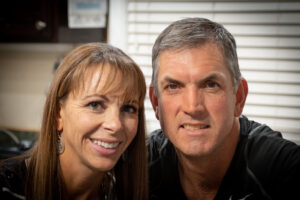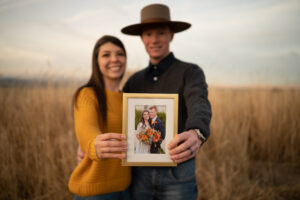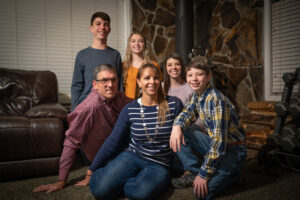The Bingham Family | DCM and Heart Transplant Survivors
Haines, OR
I know a lot of people who have not come out with their kids still alive. We’re very fortunate. We still have all five kids, and we treasure every moment we have with them.
Immensity is at home in Haines, Oregon, and the view from the Bingham family’s porch is utterly vast. Expansive high desert and grassland extends over the valley, as tributaries and streams converge and descend from the prominent eastern slopes of the Elkhorn Mountain Range, whose pearly peaks are dotted with early-season snow.
Gage rises into the frame and descends again as he bounces on the trampoline in the backyard. The youngest of the five Bingham children, he remembers what it was like to be launched into the air by his older brother and three older sisters. However, now on the cusp of his teen years, Gage has real responsibilities around the ranch.

He and Mason load several 1200 pound hay bales onto a flatbed pickup and roll out to the fields—some of the family’s 600+ acres of grazing and farmland, to feed some 400 head of cattle. Gage is still getting to know Mason, but the two bond over shared experiences in agricultural life. They both grew up in the high and dry plateaus of the mountainous west, which require ingenuity when it comes to managing the herd.
Cows come bounding toward the truck as Gage spreads the hay on the ground. He observes the cattle with a note of austerity. “I like hanging out with the animals, unless they aren’t cooperating,” he says. At times, Gage helps the calves without mothers who must be bottle fed back at the barn. His love for the ranch, and his willingness to help is appreciated by his family, especially his father, Jason, who manages the family’s ranching business on top of busy work as an accountant.
While Gage is the youngest, Mason is the newest addition to the Bingham’s immediate family. He recently married Sierra, Gage’s oldest sister, and just traveled with her from their home near Provo, Utah for a visit during their Thanksgiving break.

Going home is no quick journey, but one that Sierra has learned to enjoy as simply another aspect of hailing from the rural American West. For Sierra, long-awaited returns are almost a tradition in her household. “Family time has become very important to me,” she says. “Life is a fragile thing.” There were many times she was unsure if she would ever make the trip again.
Her wedding, which took place in October 2020, was a testament to the Binghams’ ability to continue their lives amidst an incalculable number of threats posed by a deadly genetic disease. “It’s been so awesome to have our kids reach milestones that we never thought they were going to reach,” says Stacy, their mother. All five of her and Jason’s children have either been diagnosed with dilated cardiomyopathy (DCM), or have markers for the disease, which is characterized by an enlargement and thinning of the heart muscle, weakening its ability to pump blood and elevating risk of irregular rhythms. Gage, Sierra, and Lindsey are all alive today because of heart transplants, in Sierra’s case: two. The Binghams’ story, filled with ups and downs, is a tale that spans over a decade of medical uncertainties and a family’s growing resilience.
Reuniting comes as a reminder of the gift that this family has been given—that all five kids are living is truly miraculous. The trials of living with DCM have tested everyone’s resolve, which today, has only strengthened their collaborative bonds. “What we have is the power of family,” asserts Jason. “Not everyone has that. We were able to make it through some really tough times. We kept a normal life going through all those hardships.”

Their story starts as quaint as the small town they inhabit. Jason and Stacy met at church while they were both in college. The couple married in 1997, and Stacy, originally from Utah, relocated to her husband’s hometown, where she got a job as an obstetrics nurse at a small hospital in nearby Baker City, Oregon. In the coming years, she gave birth to Sierra, Megan, and Lindsey and the family secured its future to their tiny rural town. “I just remember thinking that our lives were so happy,” says Stacy. “I thought, ‘This is too good to be true.’” The Binghams home continued to expand, and by 2006, Stacy was pregnant with their fourth child.
That May, six-year-old Sierra became ill during a T-ball game. She was nauseous and went home to rest, but the symptoms did not abate. She started missing school. “I was always tired,” she remembers. “I didn’t have energy to do anything.” Megan, just one year younger, was upset that her older sister and best bud couldn’t play Barbie anymore. Meanwhile, Stacy was suspicious. “I thought, ‘This has to be more than a cold or a flu,’” she recalls. After eliciting advice from her stepmom, a pediatric nurse, Stacy decided to get Sierra’s heart checked.
To get cardiac imaging done, Stacy and Jason had to take Sierra to a hospital in Boise, Idaho, two-and-a-half hours away, where she received an echocardiogram. The results were shocking. Sierra’s heart muscle was thin, stretched and it wasn’t pumping blood properly. She was diagnosed with DCM and told that her heart was failing. She was hospitalized for the next two weeks, at times on a ventilator, before being sent home with medication.
That July, Sierra’s condition deteriorated, and she went back to the hospital in Boise for more imaging. The news was dire. “We were told that without a transplant, Sierra would die,” explains Jason. Sierra herself remembers little from this time. “The human mind tries to protect itself,” she says. “It blocks some of the hard stuff out. I really only remember slight things. It’s blurry in my mind.”
However, it is a time her parents remember well. “Those first three weeks with Sierra were the worst three weeks of my life,” says Jason. “Then, we gained experience.” In the blink of an eye, the Binghams’ world irreversibly changed. Sierra was life-flighted to Lucile Packard Hospital in Palo Alto, California, to the cardiovascular intensive care unit (CVICU). As July turned to August, the outlook became increasingly bleak. The only option besides a transplant was an external pumping machine called a Berlin Heart that could keep Sierra’s blood circulating. But it would take five days to get the device and that was time that little Sierra likely did not have.
Somehow, in the middle of the second night, a call came to the CVICU. A donor heart had been found for Sierra, from a two-year-old boy. The following day, she went into the operating room. Prayers were spoken, and several hours later Sierra emerged from anesthesia. She felt terrible, but the operation was a success. With her parents and siblings by her side, she started a new chapter that evening in Palo Alto, however, her and her family’s story with DCM was still far from over.
The Binghams returned to Haines with a new addition to the family. Not only had Sierra survived the unthinkable, but Hunter was born while the family was still in California. With four kids and the realization that something with genetic implications might be going on, Stacy and Jason decided to get everyone screened for signs of DCM. Neither parent had any family history of heart disease, but it felt best to be safe. They all got echocardiograms, and the results were good: No other children showed markers for heart disease.
Fast-forward six years after Sierra’s troubles began, to May of 2012, and her sister, Lindsey, started experiencing a prolonged malaise. “I wasn’t feeling like myself,” Lindsey remembers. “I didn’t want to play with my siblings anymore. I went to bed crying many nights because my stomach hurt so bad.” To be on the safe side, Stacy and Jason decided to take Lindsey to the ER in Baker City for a chest x-ray. “We thought, ‘No way this could be the same thing,’” recalls Stacy. “Both of us were in denial.”
The foreboding signs were no mistake; imaging revealed that Lindsey also had DCM. “They told me that I had the same thing as Sierra,” remembers Lindsey. With knowledge of the implications, Lindsey tried to backpedal. “I told them, ‘No, I actually feel fine now!’” She understood that she might need a heart transplant, a terrifying prospect.
In an instant, it was like the replay button had been hit, taking them back to a time they never wanted to revisit. On May 30, 2012, Jason and Stacy hastily packed their bags as Lindsey was life-flighted to Palo Alto where she was admitted and placed on the transplant list. She reached out to her older sister for advice and strength. “I called Sierra, back in Haines, to ask her about her heart transplant,” Lindsay remembers. “I was scared. I asked her if it would hurt? If I could die? She said that it’s not that scary but it does hurt after the transplant.” Sierra’s experience, however frightening, was helpful for navigating the challenges to come.
Lindsey’s condition steadily declined in the hospital. That June, with adequate warning, doctors decided to implant a Berlin Heart to help Lindsey as she waited for a transplant. The external heart-pump was a literal lifesaver. Although she remained confined to the hospital, the device allowed her heart to function at near normal capacity. “It took my sister three-and-a-half weeks,” says Lindsey. “I thought that it shouldn’t take that long for me.”
Wondering if Lindsey’s condition was just another stroke of bad luck, Stacy and Jason decided to get their other children tested for DCM again via echocardiogram. “That was our D Day,” recalls Stacy. “We found out that all of our children either had cardiomyopathy or flags for the disease.” Jason and Stacy tried to come to terms with the astounding news that all five children were at risk of heart failure, and in potential need of a transplant.
Gage in particular, then only three years old, was already showing symptoms of cardiomyopathy. The normally boisterous family comedian was tired all the time and wasn’t eating right. Stacy took his pulse and blood pressure one day and noticed that it was dangerously low. She took him to the hospital. “He was in complete heart block.” Gage was having irregular heart rhythms, and was admitted to the hospital for surgery to place a pacemaker in his chest, while Lindsey lay recovering from the Berlin Heart placement—a trying day for the Binghams.
At this point, with seemingly endless turmoil on the horizon, and Lindsey still waiting for a heart, Stacy and Jason decided to relocate the whole family to Palo Alto. They moved to the Ronald McDonald House near the hospital that August, and all seven of them began living between two rooms. “That was tough for me,” reflects Megan, whose heart has thus far remained unaffected by DCM, but who’s life was certainly altered by it. “I had two drawers to put all of my stuff in… I was just starting middle school. I was used to a small town. In Haines, there were 22 kids in my grade.”
There, Lindsay and her siblings entered a very different schooling and social environment. “It was good for me to understand that the world does not revolve around Haines,” adds Sierra. “I learned that there were other people who were going through the same things as I was.” In Palo Alto and in the hospital, the Binghams were getting a real-world education, making new friends, and navigating a far more urban expanse than they had ever known. “We didn’t even know where Stanford or Palo Alto were before all of this,” laughs Jason. Immersed in a strange new world in the Bay Area, he and his family did what they always had done, adapted to the circumstances, no matter how difficult, with open minds and hope.
The relative candor and ease that the Bingham family discusses their journey is a hint at some of the changes in mentality that took place over the course of their struggles with DCM. “The growth that happens to you from going through something like this, is irreplicable,” Stacy relays. “We came out with a different perspective on life.” As Lindsey’s wait for a heart lengthened, the press began contacting her and Jason about doing stories on their children—the incredible amalgamation of a genetic heart disease with a still-unknown root cause.
It was during this time that producers from NBC’s primetime news feature, Dateline, began discussions in earnest with the Binghams about documenting their health saga. The family considered the implications. “When we first went through things with Sierra, we didn’t know what to expect,” says Stacy. Their first heart transplant had birthed new priorities for Stacy and Jason, knowing that more trouble lay ahead. “We thought it could be helpful to share our journey to raise awareness, but also to give real hope to other families in a similar position to ours,” says Stacy. Jason admits that he also hoped their openness to being documented would make Lindsey’s wait for a heart shorter.
Somewhat surprised with themselves, they agreed to let the NBC camera crew follow them, assuming they could ask them to stop filming if things ever were too intense. “They were very respectful,” says Jason. Their first documentary, Against All Odds, would feature the coming trials of Lindsey, Gage, and unexpectedly, Sierra. This was followed by an even-longer documentary in 2017, Heartbreak: Saving the Binghams.
With cameras rolling, the fall months began to pass and Lindsey continued to wait for a new heart. Every day, her siblings would bike home from school to visit her in the hospital. They would plan fun activities; play games and dance. “I had two nurses that were like two of my closest friends,” says Lindsey. “One was a day shift and one was a night shift. Lindsey was able to participate in everything with the help of her Berlin Heart on a wheelie-cart by her side at all times.
As months passed and the holidays approached, the Binghams did their best to keep spirits up. “We took over the hospital ward for Thanksgiving, and made the whole meal happen there,” recalls Megan. They imported an artificial Christmas tree and decorated it inside Lindsey’s room. As time dragged on, complicated feelings arose. “We were told that around the holidays, there are usually more transplants,” explains Stacy. The reality of the situation for a theoretical donor family hit close to home. “It is a rollercoaster of emotions that switch back and forth so fast.” “While we prayed for a heart to save our daughter’s life,” says Jason, “we prayed for the family that lost their child.”
But the holidays came and went, the calendars changed over to a new year, and the wait continued. Then, on February 12th, eight months after being placed on the transplant list, nurses informed Stacy that they had found a donor. The entire nursing staff was elated, and she rushed to find Jason and tell him the news. They proceeded to Lindsey’s room together.
“Guess what we found out?” asked Jason, entering Lindsey’s room with Stacy filming behind him with her phone. Lindsey looked around, wide-eyed, and then it hit her. “That I have a heart?!” She jumped up and down, screaming in excitement, the realization sweeping through the room to each of her siblings. “I knew it,” said Sierra, shaking her head. Lindsey embraced her parents in tears and cried softly “I did it… I did it.”
Focusing on the sickest kid has always been at the core of the Binghams strategy for keeping up with the deluge. But what happens when multiple children are sick? The next day, as Lindsey waited to go into surgery, Sierra was undergoing a routine heart catheterization when doctors discovered issues with her transplanted heart—signs of possible rejection after seven years. As a precautionary measure, Sierra was transferred to the CVICU to run more tests.
Meanwhile, Lindsey had been waiting the whole day for the word that her heart had arrived. The surgery was delayed several hours, as other organs from the donor were being matched with others in need. With any transplant, timing is critical. Organs are only viable for several hours after being removed from the donor’s body. Jason and Stacy did their best to keep positive, knowing that their future precariously rested on a razor’s edge.
Fortunately, that night Lindsey’s new heart arrived. In the early hours of Valentine’s Day, she entered the operating room with her favorite blankie to receive her transplant. After 30 hours of waiting, and six surgeons in the operating room, Lindsey had a new heart. She spent the next two weeks recovering, and then for the first time in months, was free to leave the hospital.
With Lindsey’s transplant complete, the focus shifted to Sierra, who was undergoing various treatments to try and reverse the rejection, including plasmapheresis, a procedure to filter and clean the blood plasma before returning it to the body. Doctors were hopeful but honest with the Binghams about Sierra’s predicament.
That April, another biopsy, a tissue sample of cardiac tissue, was planned for both Lindsey and Sierra. If the results were good, the Bingham family could finally count on returning home to Haines at the end of the school year. Lindsey’s new heart did not show any signs of rejection and Sierra was stable enough to leave the hospital. Filled with exuberance and relief, the family made plans to return to their home in June 2013, for the first time in the better part of a year.

As the earth seemed to shift uncontrollably under the feet of the Bingham family, it was their constant cohesion as a family that kept their spirits high when they were together. This continues today, as the delicious smells of dinner come wafting through the house as the family sits down for their Sunday Dinner. “We missed our Sunday Dinners when we were in California,” laments Jason. “Now, they are all-the-more special to us.”
Sierra, Lindsey, Hunter, Mason, and Gage all gather around the table with their parents. After saying Grace, bowls of potatoes, meat, and greens are passed and spooned onto plates and free-flowing conversation begins. Sierra asks for news of Megan, the only family member currently absent from the gathering. Megan is currently over 1000 miles away, in Del Rio, Texas, on her Church mission and won’t make it home for Thanksgiving. Sierra completed her mission a little over a year ago, and sees it as an important part of her development as a young woman in the world.

The other constant throughout the Binghams’ trials has been their faith and involvement in the Mormon church. “My parents were able to handle a lot of the stress because of our faith,” reflects Lindsey. Their spirituality gave them an outlet for understanding why they were being put through such tests, and offered support—both locally in Haines and in Palo Alto. It also helped them understand the all-important why? “What I came to realize is that everyone must face trials in their life,” reflects Jason. “Ours are just very unique.”
Life almost returned to normal in the second-half of 2013 and 2014. Lindsey’s transplanted heart was doing well, while Gage and Sierra continued to be monitored. However, Jason and Stacy never let their guard down. “If we had a doctor’s appointment in Boise, we would just pack a bag,” recalls Stacy. “We knew it was a possibility we’d have to fly out.” It was then on another trip to Boise in mid-2015, that the next chapter of their struggles was unveiled. Sierra’s transplanted heart ran with an elevated pressure at all times, and she’d developed coronary artery disease. Her body was rejecting her heart. She found herself headed back to Palo Alto.

That June, Sierra was bumped up to the highest priority for transplant (1a) and thanks to having an easy blood-type match, in only two weeks she learned that she would receive a new heart, from a 10-year-old girl. On June 16th, Sierra entered the operating room, and for the second time in her young life awoke with a new heart beating inside her chest.
“I woke up and asked my mom, ‘Are they going to do surgery?’” recalls Sierra. Stacy had to let out a small laugh. “Then, I looked down and saw all the tubes coming out of me.” The fastest the hospital had ever discharged a heart transplant recipient before was nine days, but Sierra was motivated to get home as quickly as possible. With her determination, she was discharged in eight—a new record.
As Sierra’s recovery continued from home, Gage started to struggle. A notable increase in irregular heartbeats frightened his physicians, who recommended that he go into surgery to install an implantable cardioverter defibrillator or ICD, a device that can shock his heart back into rhythm in the case of arrhythmia. That August, Gage underwent surgery to place the defibrillator.
Post-surgery, Gage never fully recovered. He lost his appetite, suffered frequent nausea, and developed trouble breathing. Gage seemed to be following in Lindsey and Sierra’s footsteps. He flew to Palo Alto, and was admitted. What became clear was that he would eventually need a transplant as well. His family braced itself for another waiting game, something they were growing used to. “I didn’t know what to think about the transplant,” remembers Gage. He saw that his sisters were still alive, but the process was burdensome. “I started to cry when I watched the videos of Sierra and Lindsey getting theirs.” Gage understood that his life, forever changed from DCM, was about to transform, in a way he knew too well, but had never directly experienced himself.
While the whole family made plans to temporarily move back to Stanford, Megan opted to stay in Haines—to stay with her classmates and friends from high school. It was a decision that she ultimately regretted. “I ended up living away from my family for my sophomore year,” says Megan. “My siblings felt like I abandoned them.” These are feelings that have since been discussed and bonds have been reaffirmed. “I ended up learning a lot about the importance of family.”
Back in California, in the years since Lindsey’s long wait in the hospital with her Berlin Heart, the technology for heart pumps had advanced. Gage’s doctors proposed installing a ventricular assist device (VAD), which would allow his heart to circulate blood properly and could be used outside the hospital. This particular VAD was smaller than others and so had an easier time fitting in the eight-year-old’s heart. In fact, Gage was one of the youngest patients at the time to receive the device, which was typically placed in adults.
Gage’s VAD allowed him time outside of the hospital for what would be a very long wait for a heart. With Stacy’s skills as a nurse, and her and Jason’s collective experience, doctors allowed him to participate in many activities. “I got to play baseball with my VAD,” recalls Gage. He also was able to attend school in person. “California was becoming our second home,” wrote Stacy on the family’s blog, “A Family of Big Hearts.” They would end up spending one year and seven months away from home.
The whole family returned to Haines for a visit during their school’s spring break. It was then, on the night of April 3rd, 2017, when the call came. Now, extremely well-rehearsed, Stacy, Hunter, and Gage flew to California, while Jason drove the rest of the family. Two days later, Gage walked himself into the operating room and after 512 days on the waitlist, underwent the fourth heart transplant in 11 years for the Bingham children.

Sunday Dinner comes to a close and the cadre of teenagers and young adults at the Bingham house swoop into action cleaning the kitchen. The clank and clatter of soapy dishes fills the house as Stacy and Jason take a moment to relax, much earned after their work on the meal itself. It’s tradition after Sunday Dinners at the Binghams for the kids to all clean up, but more tasks await. Each Sunday night is also time to organize their medicine for the week. Lindsey, Sierra, and Gage carefully fill their pillboxes—they all take a minimum six medications a day. It is simply another part of the post-transplant life.
“It’s been pretty boring since 2017,” Jason comments. “Which is wonderful!” Gage, Lindsey, and Sierra each get echocardiograms and blood tests every three months. Once a year, they all must travel to Lucile Packard Hospital at Stanford to test their transplanted hearts’ function, and assess any signs of rejection. This requires a heart catheterization and biopsy, followed by another echocardiogram. Even with numerous transplants behind them, the Binghams cannot afford to be complacent. “We try not to take things for granted,” adds Jason “At any moment, we could go to California again with issues.”
In fact, they did recently make an emergency trip to Palo Alto. “This past June [2021], I felt that my heart wasn’t beating correctly,” says Lindsey. “The rhythm was off. It was beating slow.” “We dove back into survival mode,” explains Stacy. “We just dropped everything.” She flew with Lindsey to Palo Alto to have an ICD placed, while Jason stayed home with the rest of the kids. Lindsey has since recovered well from the surgery, but continues to have issues with the (new) device.
“We have a routine we do when our kids get sick,” explains Stacy. “You just prioritize the sick kid. Make sure they get better and drop everything else. Whatever else we have scheduled is not important.” This is perhaps the most universally understood maxim in the Bingham family, required for them to remain nimble and never get too settled. “There was a lot of time when our parents weren’t able to watch us,” says Hunter. “It taught me how to be independent.” He and Megan continue to get echocardiograms every 1-2 years, and thus far have shown no signs of advancing DCM.
Transplants are not static events—completed and forgotten—but dynamic, ongoing relationships that Sierra, Lindsey, and Gage all must manage on top of their desires. Most of the time, they just want to lead normal lives. They do not spend excess time or attention on their hearts or find the need to talk about it too much. But they cannot afford to completely ignore the long-term effects or the fact that their new hearts will not last forever.
“We know that we’re not done with this yet,” says Jason, his tone pronounced but matter-of-fact. “They can’t live forever with a transplanted heart. They are probably going to pass before we do. I hope not, but that’s something I have to wrap my head around.”
And the Bingham kids are busy navigating many problems that come with being chronically ill—being constantly “at risk.” For Sierra and Mason, this has fundamentally changed the way they have begun planning a family together. “With two heart transplants, my doctors tell me that it would be best not to have children,” says Sierra. The assessment was heartbreaking, but now, she and Mason are investigating other methods such as adoption or surrogacy, ideas that would not initially have appealed to her. “The miracle for us is: that doesn’t determine our worth,” says Mason. His commitment as a partner, despite Sierra’s health challenges, is imperative for her health as well now that she is living more independently and needs access to good health insurance.
“It’s quite an adjustment to get a biopsy without her mom, just her husband,” relays Jason. When the two got engaged, he and Stacy talked frankly with Mason about what it would mean to marry Sierra, transferring years of hard learning and experience. Needless to say, his heart was his guide and now the two are learning to tackle obstacles together, as adults.

Perhaps one of the healthiest aspects of the Binghams’ life is their competitive spirit. Lindsey shuffles and deals out a deck of cards as the whole family sits down to play. She and her siblings are avid athletes, and heavily involved in local sports. Only yesterday, the whole family drove five hours to Bend, Oregon, to see Hunter play in the semi-final match for their division. The victorious football team now heads to the finals the following weekend. After football season, Hunter will jump directly into basketball, followed by track and field in the spring. Gage too, plays basketball, and wishes he could play on the football team. Despite his physical restrictions, this past year Gage was able to help out the football teams at practices, assisting the coaching. Lindsey is an avid volleyball player, and at this point, her doctors have approved of her playing the sport.
For Lindsey, the transition to adulthood has not been overshadowed by heart complications, but that doesn’t make it any easier. “The growth that they have when they leave home has been so rewarding,” says Stacy. Lindsey is on the cusp and like her two older sisters, is interested in going into healthcare, specifically becoming a nurse like her mother. Meanwhile, Megan is starting to work toward medical school, while Sierra is studying social work—all inspired, in no small way, by the care they experienced and witnessed throughout their experiences.
Having the kids grow up and leave home makes the special bond they share glow in a beautiful way when they are together. They have faced unique hardships that few others know and stayed strong in the face of uncertainty. The Binghams’ travails are far from over, but importantly, they have learned not to sweat the small stuff and to take full advantage of the time they have together. “I know a lot of people who did not come out with their kids still alive,” says Stacy. “We’re very fortunate. We still have all five kids, and we want to treasure every moment we have with them.” For now, the Binghams hope, pray, and keep making family memories together.

